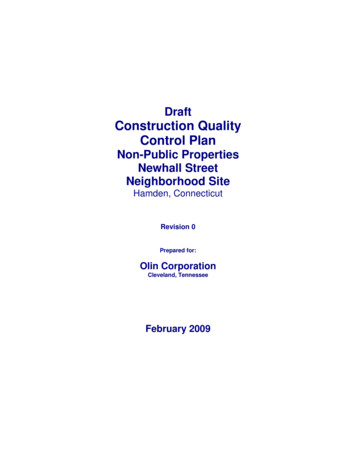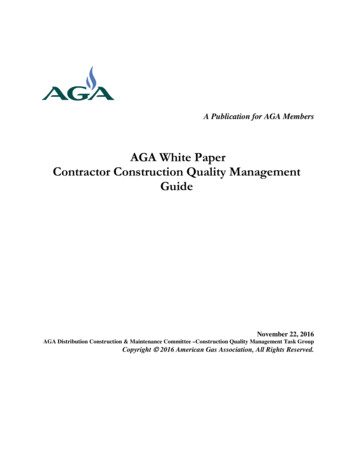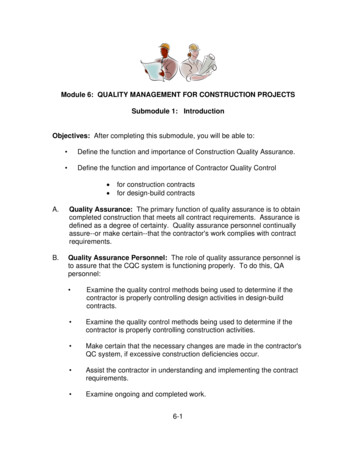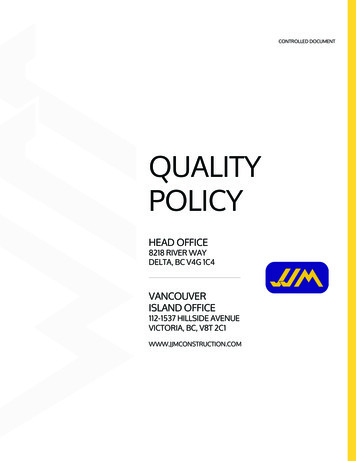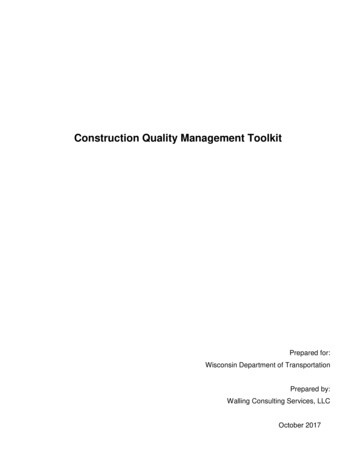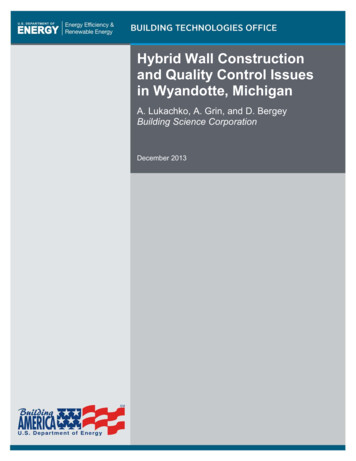
Transcription
CONSTRUCTION QUALITYIN SOUTH AFRICA;A client perspective
Copyright 2011ISBN: 978-0-621-40169-1
CONSTRUCTION QUALITY IN SOUTH AFRICA: A CLIENT PERSPECTIVE
i
CONSTRUCTION QUALITY IN SOUTH AFRICA: A CLIENT PERSPECTIVEEXECUTIVE SUMMARYThe cidb was established by an Act of Parliament (Act 38 of 2000), with a mandate (amongst others) to:. promote the contribution of the construction industry in meeting national constructiondemand and in advancing:i) national, social and economic development objectives;ii) industry performance, efficiency and competitiveness; andiii) improved value to clients.Value to clients is a very complex and often subjective issue, but it is recognised that quality of constructionis a key component of perceived value to clients. As noted by FIDIC, “lack of quality in construction ismanifested in poor or non-sustainable workmanship, and unsafe structures; and in delays, cost overruns anddisputes in construction contracts”. Value and quality of construction is of concern to both public and privatesector clients.Against this background, the cidb has undertaken this study on the quality of construction in South Africa.This investigation is undertaken largely from a client perspective (and largely from a public sector clientperspective), and concludes by highlighting those actions that clients can implement to derive higher qualityon their construction projects. The report investigates the factors impacting on construction quality throughthe value chain in creating new capital works, namely design, procurement and construction. (The impact ofoperation and maintenance on construction quality is not discussed here, and reference to this can be foundin various documents dealing with the National Infrastructure Maintenance Strategy (NIMS)).The report on construction quality draws on two key studies, namely the annual cidb Construction IndustryIndicators (CIIs) which contains a significant amount of information on construction quality; together with aresearch report on the state of construction quality commissioned for this study. This latter study includedsurveys of clients, designers and contractors.The report first presents an overview of the state of construction quality in South Africa, from which it isshown that clients are neutral or dissatisfied with the quality of construction on around 20% of all projects,and around 12% of the projects surveyed had levels of defects which are regarded as inappropriate. It isargued that clients should not be complacent with these levels of dissatisfaction, and that clients shouldstrive to get better value for money.The report also notes that client dissatisfaction is highest in the residential building sector, followed byspecial works and non-residential building. Specifically, low- and middle-income residential construction wasranked the lowest in terms of quality achieved (typically ranked poor to average quality), while the quality ofupper-income residential was ranked as average to good. The report then notes that due to a regulatoryconstraint in which homebuilders are exempt from registering with the cidb, clients in fact do not have theflexibility to specify a requirement for using cidb registered contractors (in addition to the existing NHBRCrequirements).Significantly, it is concluded that client dissatisfaction with the quality of completed on around 2% of theprojects surveyed in 2009 translates to dissatisfaction on completed work in the public sector to a value ofaround R3,5 billion per year!The report then investigates the barriers to quality in construction, which include the traditional barrierswithin the design, procurement and construction processes. However, it is noted that corruption, politicalinterference and institutional barriers are becoming increasingly more dominant in South Africa. It is thenpostulated that the majority of those cases in which clients are dissatisfied with construction quality couldprobably be attributed largely to procurement related barriers (including fraud and corruption) in theii
appointment of contractors that were not capable of undertaking the necessary work. It is further assumedthat the majority of those cases in which clients are neither satisfied nor dissatisfied (i.e. neutral) withconstruction quality could probably be attributed largely to design or construction related barriers, orattributable to barriers in the role of the client’s agent in not ensuring quality.Following this, the barriers to quality in designing for and specifying quality are investigated, which highlightconcerns that are being observed regarding a deteriorating capacity necessary to develop and maintaintechnical standards, codes and specifications, as well as a deteriorating design capability in South Africa. Areview of international experience follows, which emphasises the importance of adopting procurementmethods that specifically provide for the selection of professional services for the appointment of designservices based on quality criteria.The report then goes on to investigate the barriers to quality arising through the process of procuringcontractors, namely that of matching a contractor’s capabilities to the requirements of the project, as well aspolitical interference, cronyism, and fraud and corruption. Specifically, it is noted that the cidb Register ofContractors and the NHBRC Register of Homebuilders does not provide a reliable indicator of a contractor’sability to deliver quality – and specifically for the lower grade contractors. International practice suggests thatan assessment of competencies, construction management systems, and previous performance should beused to pre-qualify contractors and/or to assess their potential to deliver quality – on which the cidb BestPractice Contractor Recognition Scheme has been based.Specifically, this report has highlighted the use of procurement systems in the public sector based on priceand preference only, and not taking into account functionality (or quality), as a barrier to constructionquality. For example, 25% of provincial and local authority contracts awarded were not adjudicated on thebasis of quality, and 13% of provincial and local authority contracts were not awarded in line with tendercommittee recommendations.The report has also highlighted international trends aimed at enhancing construction quality and value formoney by promoting procurement strategies and contract types that support the development ofcollaborative relationships between government clients and its suppliers, including the early appointment ofintegrated supply teams. The report notes that in the UK, for example, traditional, non-integratedprocurement approaches should not be used unless it can be clearly shown that they offer best value formoney – which means, in practice, that they will seldom be used.Together with a lack of procurement capacity in client departments, a contributing factor to the focus onprice and preference is insufficient information to be able to select professional services and/or contractorsbased on quality criteria – and it is seen that the cidb Best Practice Contractor Recognition Scheme togetherwith cidb Contractor Performance Reports will contribute towards providing the necessary information.Of specific concern in the report are indications that corruption is increasing rapidly in South Africa – andone such view is that South Africa is reaching a tipping point beyond which it may be very difficult to reversecorruption in the public sector. It is noted in the report that the cidb has aggressively dealt with corruptionlinked to the cidb Register of Contractors, and that the cidb investigates cases of fraudulent award of tendersthat are reported to it. However, it is noted that the cidb has not adequately dealt with the broader issue ofdeveloping and implementing mechanisms to proactively prevent and/or identify corruption withinconstruction procurement. Strong consideration should be given by the cidb to introduce requirements forintegrity management and transparency in construction procurement.Finally, the report investigates the key construction site related barriers to quality, namely process issues andskills and competence issues, as well as the effectiveness of the client’s representative in ensuringcompliance by the contractor with the client’s quality specification.The report highlights the various actions that are being developed by the cidb which are aimed at enhancingconstruction skills and construction quality, and recognises and acknowledges the initiatives beingundertaken by the industry in addressing the skills shortages – particularly at the level of skilled and semiskilled workers.iii
The report also highlights local and international experience that suggests that greater attention also needsto be focused on the role of the client’s agent in construction quality – for example using performancemanagement systems similar to those advocated by the cidb for assessing the performance of contractorsand design services.In addition, this section presents a brief overview of the highly successful CONQUAS system developed bythe BCA in Singapore, which is being used in Singapore as the basis for a construction quality bonusscheme, using merit and demerit points. The report notes that strong consideration should be given tointroducing CONQUAS in South Africa – as a basis for ‘absolute’ measurements of construction quality.Finally, the report notes that a consistent underlying theme to improving the quality of construction in SouthAfrica is the ‘management of quality’ – which must permeate across all stakeholders in the constructiondelivery chain (as well as, in fact, the operation and maintenance of infrastructure). Key to this is the needfor adequate exposure to quality management in the course content at all levels of schooling in the builtenvironment, and the CBE therefore needs to assess and, where appropriate, strengthen the requirementsfor ‘quality management’ in the course content within built environment academic institutions.The report concludes with specific recommendations that the cidb and other stakeholders could action tosupport enhanced construction quality in South Africa, namely:i)In addition to the existing mandatory NHBRC requirements, clients should be able to have theflexibility to specify additional requirements for procuring from cidb registered contractors in theresidential building sector, where appropriate.ii)The cidb should advocate for the maintenance of the necessary technical capacity for thedevelopment and maintenance of construction standards, codes and specifications – including that atthe SABS and the CSIR.iii)Strong consideration should be given by the cidb to introduce requirements for integrity andtransparency in construction procurement.iv)Strong consideration should be given by the cidb to advocate for procurement and delivery modelspromoting collaborative relationships and integrated supply teams (including design and buildcontracting strategies).v)The cidb needs to continue to advocate for and to strengthen requirements for the appointment ofprofessional services and contractors based on quality criteria – supported by performanceassessment reports for professional service providers and contractors.vi)The cidb should investigate the possible use of performance assessment reports for the client’s agentin the public sector as a best practice.vii)The cidb must continue to advocate for a building and construction component to be incorporatedinto the South African World Skills activities – and should actively seek to incorporate a constructionskills component into the South African delegation.viii)Strong consideration should be given by the cidb to piloting and testing the Singapore BCACONQUAS system in South Africa.ix)The CBE should assess and (where appropriate) strengthen the requirements for ‘qualitymanagement’ in the course content within built environment academic institutions.iv
v
CONSTRUCTION QUALITY IN SOUTH AFRICA: A CLIENT PERSPECTIVEExecutive Summary ii1Background and Introduction 122.12.22.32.42.5State of Construction Quality 3Overview 3The Residential Building Sector 4Client Perceptions 6International Trends 6Summary 733.13.23.3Barriers to Quality 8Overview 8A Case Study: Low Income Housing 9Summary 1144.14.24.34.44.5Designing and Specifying Quality 12Standards and Specifications 12Designing for Quality 13Procuring Design Quality 14International Trends 15Summary 1855.15.25.35.4Procuring Quality Construction 19Matching Capabilities with Requirements 19Bribery, Fraud and Corruption 23International Trends 27Summary
an assessment of competencies, construction management systems, and previous performance should be used to pre-qualify contractors and/or to assess their potential to deliver quality – on which the cidb Best Practice Contractor Recognition Scheme has been based. Specifically, this report has highlighted the use of procurement systems in the public sector based on price and preference only .



